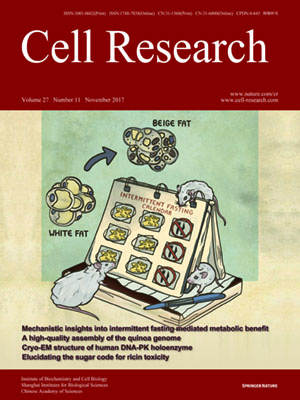
Volume 27, No 11, Nov 2017
ISSN: 1001-0602
EISSN: 1748-7838 2018
impact factor 17.848*
(Clarivate Analytics, 2019)
Volume 27 Issue 11, November 2017: 1365-1377
ORIGINAL ARTICLES
Molecular mechanism of directional CTCF recognition of a diverse range of genomic sites
Maolu Yin1,2, Jiuyu Wang1, Min Wang1, Xinmei Li1,2, Mo Zhang3,4,5, Qiang Wu3,4,5 and Yanli Wang1,2,6
1Key Laboratory of RNA Biology, CAS Center for Excellence in Biomacromolecules, Institute of Biophysics, Chinese Academy of Sciences, Beijing 100101, China;
2University of Chinese Academy of Sciences, Beijing 100049, China;
3Center for Comparative Biomedicine, MOE Key Laboratory of Systems Biomedicine, Institute of Systems Biomedicine, Collaborative Innovative Center of Systems Biomedicine, SCSB, Shanghai Jiao Tong University (SJTU), Shanghai 200240, China;
4State Key Laboratory of Oncogenes and Related Genes, SJTU Medical School, Shanghai 200240, China;
5School of Life Sciences and Biotechnology, SJTU, Shanghai 200240, China;
6Collaborative Innovation Center of Genetics and Development, Shanghai 200438, China
Correspondence: Yanli Wang, E-mail: ylwang@ibp.ac.cn; Qiang Wu,(qwu123@gmail.com)
CTCF, a conserved 3D genome architecture protein, determines proper genome-wide chromatin looping interactions through directional binding to specific sequence elements of four modules within numerous CTCF-binding sites (CBSs) by its 11 zinc fingers (ZFs). Here, we report four crystal structures of human CTCF in complex with CBSs of the protocadherin (Pcdh) clusters. We show that directional CTCF binding to cognate CBSs of the Pcdh enhancers and promoters is achieved through inserting its ZF3, ZFs 4-7, and ZFs 9-11 into the major groove along CBSs, resulting in a sequence-specific recognition of module 4, modules 3 and 2, and module 1, respectively; and ZF8 serves as a spacer element for variable distances between modules 1 and 2. In addition, the base contact with the asymmetric “A” in the central position of modules 2-3, is essential for directional recognition of the CBSs with symmetric core sequences but lacking module 1. Furthermore, CTCF tolerates base changes at specific positions within the degenerated CBS sequences, permitting genome-wide CTCF binding to a diverse range of CBSs. Together, these complex structures provide important insights into the molecular mechanisms for the directionality, diversity, flexibility, dynamics, and conservation of multivalent CTCF binding to its cognate sites across the entire human genome.
10.1038/cr.2017.131
FULL TEXT | PDF
Browse 1888


